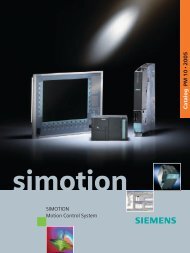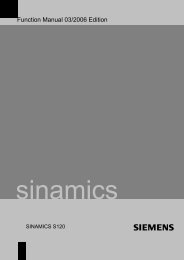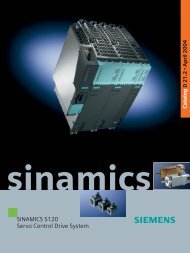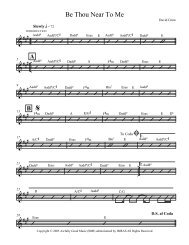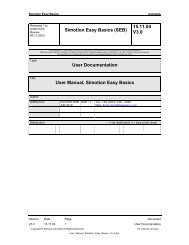- Page 1 and 2:
SIMATIC Distributed I/O System ET 2
- Page 3 and 4:
Table of contents 1 Terminal module
- Page 5 and 6:
Table of contents 4.3 Basics of ana
- Page 7:
Table of contents Table 4-10 SIMATI
- Page 10 and 11:
Terminal modules 1.1 Terminal modul
- Page 12 and 13:
Terminal modules 1.3 TM-P15S22-01,
- Page 14 and 15:
Terminal modules 1.4 TM-P30S44-A0 a
- Page 16 and 17:
Terminal modules 1.5 TM-PF30S47-F1
- Page 18 and 19:
Terminal modules 1.6 TM-E15S26-A1,
- Page 20 and 21:
Terminal modules 1.8 TM-E15S24-01,
- Page 22 and 23:
Terminal modules 1.9 TM-E15S23-01,
- Page 24 and 25:
Terminal modules 1.10 Terminal modu
- Page 26 and 27:
Terminal modules 1.12 TM-E30S44-01
- Page 28 and 29:
Terminal modules 1.13 TM-C120S and
- Page 30 and 31:
Terminal modules 1.14 TE-U120S4x10
- Page 32 and 33:
Power modules 2.2 Parameters for po
- Page 34 and 35:
Power modules 2.3 PM-E 24 VDC power
- Page 36 and 37:
Power modules 2.4 PM-E 24-48 VDC po
- Page 38 and 39:
Power modules 2.4 PM-E 24-48 VDC po
- Page 40 and 41:
Power modules 2.5 PM-E 24-48 VDC/24
- Page 42 and 43:
Power modules 2.5 PM-E 24-48 VDC/24
- Page 44 and 45:
Power modules 2.6 Placing power mod
- Page 46 and 47:
Power modules 2.7 Example of a conf
- Page 48 and 49:
Power modules 2.8 Finding the corre
- Page 50 and 51:
Digital electronic modules 3.1 Para
- Page 52 and 53:
Digital electronic modules 3.2 Para
- Page 54 and 55:
Digital electronic modules 3.2 Para
- Page 56 and 57:
Digital electronic modules 3.3 2DI
- Page 58 and 59:
Digital electronic modules 3.3 2DI
- Page 60 and 61:
Digital electronic modules 3.4 4DI
- Page 62 and 63:
Digital electronic modules 3.4 4DI
- Page 64 and 65:
Digital electronic modules 3.5 4DI
- Page 66 and 67:
Digital electronic modules 3.5 4DI
- Page 68 and 69:
Digital electronic modules 3.6 2DI
- Page 70 and 71:
Digital electronic modules 3.6 2DI
- Page 72 and 73:
Digital electronic modules 3.7 4DI
- Page 74 and 75:
Digital electronic modules 3.7 4DI
- Page 76 and 77:
Digital electronic modules 3.8 4DI
- Page 78 and 79:
Digital electronic modules 3.8 4DI
- Page 80 and 81:
Digital electronic modules 3.9 4DI
- Page 82 and 83:
Digital electronic modules 3.9 4DI
- Page 84 and 85:
Digital electronic modules 3.9 4DI
- Page 86 and 87:
Digital electronic modules 3.9 4DI
- Page 88 and 89:
Digital electronic modules 3.9 4DI
- Page 90 and 91:
Digital electronic modules 3.10 2DI
- Page 92 and 93:
Digital electronic modules 3.10 2DI
- Page 94 and 95:
Digital electronic modules 3.11 2DI
- Page 96 and 97:
Digital electronic modules 3.12 2DO
- Page 98 and 99: Digital electronic modules 3.12 2DO
- Page 100 and 101: Digital electronic modules 3.13 Sta
- Page 102 and 103: Digital electronic modules 3.13 Sta
- Page 104 and 105: Digital electronic modules 3.14 2DO
- Page 106 and 107: Digital electronic modules 3.14 2DO
- Page 108 and 109: Digital electronic modules 3.15 2DO
- Page 110 and 111: Digital electronic modules 3.15 2DO
- Page 112 and 113: Digital electronic modules 3.16 4DO
- Page 114 and 115: Digital electronic modules 3.16 4DO
- Page 116 and 117: Digital electronic modules 3.17 2DO
- Page 118 and 119: Digital electronic modules 3.17 2DO
- Page 120 and 121: Digital electronic modules 3.18 2DO
- Page 122 and 123: Digital electronic modules 3.18 2DO
- Page 124 and 125: Digital electronic modules 3.19 2RO
- Page 126 and 127: Digital electronic modules 3.19 2RO
- Page 128 and 129: Digital electronic modules 3.19 2RO
- Page 130 and 131: Digital electronic modules 3.20 2RO
- Page 132 and 133: Digital electronic modules 3.20 2RO
- Page 134 and 135: Digital electronic modules 3.20 2RO
- Page 136 and 137: Analog electronics modules 4.2 Anal
- Page 138 and 139: Analog electronics modules 4.2 Anal
- Page 140 and 141: Analog electronics modules 4.2 Anal
- Page 142 and 143: Analog electronics modules 4.2 Anal
- Page 144 and 145: Analog electronics modules 4.2 Anal
- Page 146 and 147: Analog electronics modules 4.2 Anal
- Page 150 and 151: Analog electronics modules 4.3 Basi
- Page 152 and 153: Analog electronics modules 4.3 Basi
- Page 154 and 155: Analog electronics modules 4.3 Basi
- Page 156 and 157: Analog electronics modules 4.3 Basi
- Page 158 and 159: Analog electronics modules 4.3 Basi
- Page 160 and 161: Analog electronics modules 4.4 Resp
- Page 162 and 163: Analog electronics modules 4.5 Para
- Page 164 and 165: Analog electronics modules 4.5 Para
- Page 166 and 167: Analog electronics modules 4.5 Para
- Page 168 and 169: Analog electronics modules 4.5 Para
- Page 170 and 171: Analog electronics modules 4.5 Para
- Page 172 and 173: Analog electronics modules 4.6 2AI
- Page 174 and 175: Analog electronics modules 4.6 2AI
- Page 176 and 177: Analog electronics modules 4.7 2AI
- Page 178 and 179: Analog electronics modules 4.7 2AI
- Page 180 and 181: Analog electronics modules 4.8 2AI
- Page 182 and 183: Analog electronics modules 4.8 2AI
- Page 184 and 185: Analog electronics modules 4.9 2AI
- Page 186 and 187: Analog electronics modules 4.9 2AI
- Page 188 and 189: Analog electronics modules 4.10 4AI
- Page 190 and 191: Analog electronics modules 4.10 4AI
- Page 192 and 193: Analog electronics modules 4.11 2AI
- Page 194 and 195: Analog electronics modules 4.11 2AI
- Page 196 and 197: Analog electronics modules 4.12 2AI
- Page 198 and 199:
Analog electronics modules 4.12 2AI
- Page 200 and 201:
Analog electronics modules 4.13 2AI
- Page 202 and 203:
Analog electronics modules 4.13 2AI
- Page 204 and 205:
Analog electronics modules 4.14 2AI
- Page 206 and 207:
Analog electronics modules 4.14 2AI
- Page 208 and 209:
Analog electronics modules 4.15 2AI
- Page 210 and 211:
Analog electronics modules 4.15 2AI
- Page 212 and 213:
Analog electronics modules 4.16 2AI
- Page 214 and 215:
Analog electronics modules 4.16 2AI
- Page 216 and 217:
Analog electronics modules 4.16 2AI
- Page 218 and 219:
Analog electronics modules 4.16 2AI
- Page 220 and 221:
Analog electronics modules 4.16 2AI
- Page 222 and 223:
Analog electronics modules 4.17 2AI
- Page 224 and 225:
Analog electronics modules 4.17 2AI
- Page 226 and 227:
Analog electronics modules 4.17 2AI
- Page 228 and 229:
Analog electronics modules 4.18 2AI
- Page 230 and 231:
Analog electronics modules 4.18 2AI
- Page 232 and 233:
Analog electronics modules 4.19 2AO
- Page 234 and 235:
Analog electronics modules 4.19 2AO
- Page 236 and 237:
Analog electronics modules 4.20 2AO
- Page 238 and 239:
Analog electronics modules 4.20 2AO
- Page 240 and 241:
Analog electronics modules 4.21 2AO
- Page 242 and 243:
Analog electronics modules 4.21 2AO
- Page 244 and 245:
Analog electronics modules 4.22 2AO
- Page 246 and 247:
Analog electronics modules 4.22 2AO
- Page 248 and 249:
Analog electronics modules 4.22 2AO
- Page 250 and 251:
4 IQ-SENSE (6ES7138-4GA00-0AB0) 5.2
- Page 252 and 253:
4 IQ-SENSE (6ES7138-4GA00-0AB0) 5.2
- Page 254 and 255:
4 IQ-SENSE (6ES7138-4GA00-0AB0) 5.2
- Page 256 and 257:
4 IQ-SENSE (6ES7138-4GA00-0AB0) 5.3
- Page 258 and 259:
4 IQ-SENSE (6ES7138-4GA00-0AB0) 5.3
- Page 260 and 261:
4 IQ-SENSE (6ES7138-4GA00-0AB0) 5.3
- Page 262 and 263:
4 IQ-SENSE (6ES7138-4GA00-0AB0) 5.4
- Page 264 and 265:
4 IQ-SENSE (6ES7138-4GA00-0AB0) 5.4
- Page 266 and 267:
Potential distributor module 6.1 Po
- Page 268 and 269:
Potential distributor module 6.1 Po
- Page 270 and 271:
RESERVE modules Pin assignment Note
- Page 272 and 273:
Glossary Configuration Connecting t
- Page 274 and 275:
Glossary Frequency converter Ground
- Page 276 and 277:
Glossary Power modules Prewiring Pr
- Page 278 and 279:
Glossary Real time Reference potent
- Page 280 and 281:
Glossary Terminal modules Terminati
- Page 282 and 283:
Index Analog electronic module 2AI
- Page 284 and 285:
Index T Terminal module TM-E15S24-0
- Page 286 and 287:
Safety Guidelines This manual conta
- Page 288 and 289:
Table of contents ET 200S iv Produc
- Page 290 and 291:
Introduction ET 200S 1-2 Product In
- Page 292 and 293:
New Information About the "ET 200S
- Page 294 and 295:
New Information About the "ET 200S
- Page 296 and 297:
New Information About the "ET 200S
- Page 298 and 299:
New Information About the "ET 200S
- Page 300 and 301:
New Information About the "ET 200S
- Page 302 and 303:
New Information About the "ET 200S
- Page 304 and 305:
New Information About the "ET 200S
- Page 306 and 307:
New Information About the "ET 200S
- Page 308 and 309:
New Information About the "ET 200S
- Page 310 and 311:
New Information About the "ET 200S
- Page 312 and 313:
New Information About the "ET 200S
- Page 314 and 315:
New Information About the "ET 200S
- Page 316 and 317:
New Information About the "ET 200S
- Page 318 and 319:
Index ET 200S Index-2 Product Infor
- Page 320 and 321:
Safety Guidelines This manual conta
- Page 322 and 323:
Table of contents Distributed I/O S
- Page 324 and 325:
Introduction 1.1 Introduction Distr
- Page 326 and 327:
Product Information 2.2 Digital Ele
- Page 328 and 329:
Product Information 2.2 Digital Ele
- Page 330 and 331:
Product Information 2.2 Digital Ele
- Page 332 and 333:
Product Information 2.3 Digital Ele
- Page 334 and 335:
Product Information 2.3 Digital Ele
- Page 336 and 337:
Product Information 2.3 Digital Ele
- Page 338 and 339:
Index Distributed I/O System ET 200
- Page 340 and 341:
Product Information on Manual Distr



